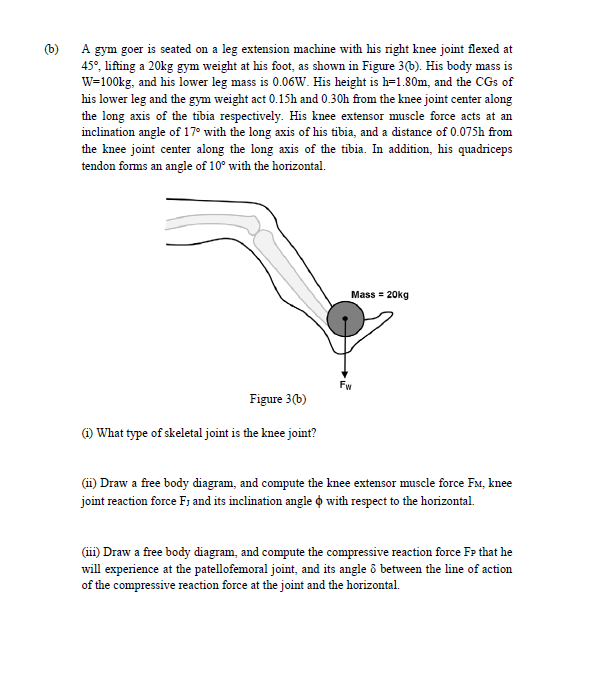A gym goer is seated on a leg extension machine with his right knee joint flexed at 45°, lifting a 20kg gym weight at his foot, as shown in Figure 3(b). His body mass is W=100kg, and his lower leg mass is 0.06W. His height is h=1.80m, and the CGs of his lower leg and the gym weight act 0.15h and 0.30h from the knee joint center along the long axis of the tibia respectively. His knee extensor muscle force acts at an inclination angle of 17° with the long axis of his tibia, and a distance of 0.075h from the knee joint center along the long axis of the tibia. In addition, his quadriceps tendon forms an angle of 10° with the horizontal. Mass = 20kg Fw Figure 3(b) @ What type of skeletal joint is the knee joint? (ii) Draw a free body diagram, and compute the knee extensor muscle force Fax, knee joint reaction force Fy and its inclination angle o with respect to the horizontal. (iii) Draw a free body diagram, and compute the compressive reaction force Fp that he will experience at the patellofemoral joint, and its angle ô between the line of action of the compressive reaction force at the joint and the horizontal.
A gym goer is seated on a leg extension machine with his right knee joint flexed at 45°, lifting a 20kg gym weight at his foot, as shown in Figure 3(b). His body mass is W=100kg, and his lower leg mass is 0.06W. His height is h=1.80m, and the CGs of his lower leg and the gym weight act 0.15h and 0.30h from the knee joint center along the long axis of the tibia respectively. His knee extensor muscle force acts at an inclination angle of 17° with the long axis of his tibia, and a distance of 0.075h from the knee joint center along the long axis of the tibia. In addition, his quadriceps tendon forms an angle of 10° with the horizontal. Mass = 20kg Fw Figure 3(b) @ What type of skeletal joint is the knee joint? (ii) Draw a free body diagram, and compute the knee extensor muscle force Fax, knee joint reaction force Fy and its inclination angle o with respect to the horizontal. (iii) Draw a free body diagram, and compute the compressive reaction force Fp that he will experience at the patellofemoral joint, and its angle ô between the line of action of the compressive reaction force at the joint and the horizontal.
Elements Of Electromagnetics
7th Edition
ISBN:9780190698614
Author:Sadiku, Matthew N. O.
Publisher:Sadiku, Matthew N. O.
ChapterMA: Math Assessment
Section: Chapter Questions
Problem 1.1MA
Related questions
Question
Please answer all subparts aligned with our honor code.

Transcribed Image Text:A gym goer is seated on a leg extension machine with his right knee joint flexed at
45°, lifting a 20kg gym weight at his foot, as shown in Figure 3(b). His body mass is
W=100kg, and his lower leg mass is 0.06W. His height is h=1.80m, and the CGs of
his lower leg and the gym weight act 0.15h and 0.30h from the knee joint center along
the long axis of the tibia respectively. His knee extensor muscle force acts at an
inclination angle of 17° with the long axis of his tibia, and a distance of 0.075h from
the knee joint center along the long axis of the tibia. In addition, his quadriceps
tendon forms an angle of 10° with the horizontal.
(b)
Mass = 20kg
Fw
Figure 3(b)
1) What type of skeletal joint is the knee joint?
(ii) Draw a free body diagram, and compute the knee extensor muscle force Fx, knee
joint reaction force F; and its inclination angle o with respect to the horizontal.
(iii) Draw a free body diagram, and compute the compressive reaction force Fr that he
will experience at the patellofemoral joint, and its angle ô between the line of action
of the compressive reaction force at the joint and the horizontal.
Expert Solution
This question has been solved!
Explore an expertly crafted, step-by-step solution for a thorough understanding of key concepts.
This is a popular solution!
Trending now
This is a popular solution!
Step by step
Solved in 2 steps with 2 images

Knowledge Booster
Learn more about
Need a deep-dive on the concept behind this application? Look no further. Learn more about this topic, mechanical-engineering and related others by exploring similar questions and additional content below.Recommended textbooks for you

Elements Of Electromagnetics
Mechanical Engineering
ISBN:
9780190698614
Author:
Sadiku, Matthew N. O.
Publisher:
Oxford University Press

Mechanics of Materials (10th Edition)
Mechanical Engineering
ISBN:
9780134319650
Author:
Russell C. Hibbeler
Publisher:
PEARSON

Thermodynamics: An Engineering Approach
Mechanical Engineering
ISBN:
9781259822674
Author:
Yunus A. Cengel Dr., Michael A. Boles
Publisher:
McGraw-Hill Education

Elements Of Electromagnetics
Mechanical Engineering
ISBN:
9780190698614
Author:
Sadiku, Matthew N. O.
Publisher:
Oxford University Press

Mechanics of Materials (10th Edition)
Mechanical Engineering
ISBN:
9780134319650
Author:
Russell C. Hibbeler
Publisher:
PEARSON

Thermodynamics: An Engineering Approach
Mechanical Engineering
ISBN:
9781259822674
Author:
Yunus A. Cengel Dr., Michael A. Boles
Publisher:
McGraw-Hill Education

Control Systems Engineering
Mechanical Engineering
ISBN:
9781118170519
Author:
Norman S. Nise
Publisher:
WILEY

Mechanics of Materials (MindTap Course List)
Mechanical Engineering
ISBN:
9781337093347
Author:
Barry J. Goodno, James M. Gere
Publisher:
Cengage Learning

Engineering Mechanics: Statics
Mechanical Engineering
ISBN:
9781118807330
Author:
James L. Meriam, L. G. Kraige, J. N. Bolton
Publisher:
WILEY